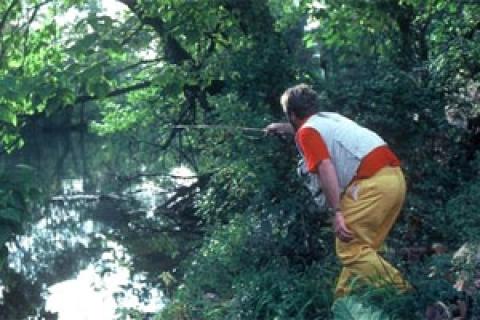
Novice fly fishermen often think the farther they cast, the more trout they'll catch. Actually, more often than not, carefully stalking and wading and then a short, accurate cast is a better approach. In fact, sometimes even no cast at all is the most effective fishing technique.
The method is called "dapping." At times it can mean the difference between a mediocre day or memorable day on the stream, accounting for those hook-jawed, reclusive old trout that simply cannot be reached with a traditional cast.

How to Dap
Dapping consists of fishing a fly without casting it. To dap a trout, first carefully stalk up to within rod's length of the fish without spooking it-typically on your hands and knees or at least in a crouched position. Then, ever-so-slowly, extend the rod with 4-10 feet of leader dangling from the tip and gently place the fly over the fish.
If you haven't spooked the fish as you approached, a take is almost guaranteed.
To improve my chances for successful dapping, I stay back as far from the fish as possible. A long rod helps with this approach, since it allows you to reach farther with the fly.
If you're imitating a lightweight insect such as a mayfly, caddis or leafhopper, drop it gently onto the water a few inches upstream from the fish and let it drift down into its feeding lane. If you're using a heavier fly such as a beetle, cricket or grasshopper, it sometimes pays to drop the fly down with a "splat" to imitate a natural falling clumsily into the stream.
Oddly enough, dropping these heavier patterns to the side or slightly behind the fish with a "plop" is often most effective. This takes the fish by surprise and often elicits an instinctive strike when the trout whirls around and sees the insect. Since it's behind his normal holding position, he realizes he must grab it quickly or it will float downstream out of reach. A walloping strike is usually the result.
When You Should Dap
Any trout near the bank can be dapped, but the technique comes into its prime when a fish is ensconced in a labyrinth of tangled brush or beneath an overhanging tree branch where a traditional cast can't be delivered. Sneak up and drop the fly over the trout through openings in the shrubbery. Dapping is also useful when tall grasses would catch the leader and mar a presentation from shore or when a cast into an eddy from mid-stream would be caught in intervening currents and drag. It works well on small, wooded streams, too, when you don't have room for a normal backcast.
Where Dapping Started
Dapping is not new. But it's a technique that's often neglected by anglers who seem obsessed with wading deeper and throwing longer lengths of line than the fisherman next to them.
Charles Cotton, writing in The Compleat Angler centuries ago, described the method well. Writing about trout hovering close to the bank of the stream, he says, "these are to be angled (for) with a short line and this way of fishing we call dapping...where in you are always to have your line flying before you up or down the river as the wind serves, and to angle as near as you can to the bank of the same side whereon you stand. You are in this kind of angling to expect the biggest fish."
Dapping is certainly not the answer for all trout fishing situations. It's simply one tactic to have in your arsenal of techniques for use on trout that can't be taken with traditional deliveries-fish that are often the heaviest ones in the stream.
- 6224 views

